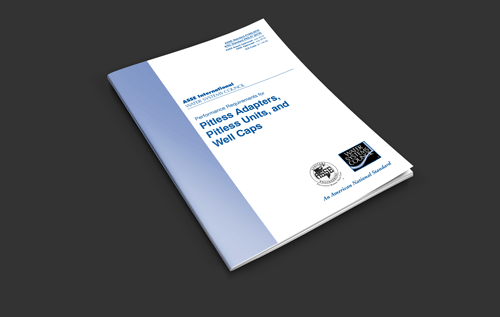Private water wells and small, shared wells serve more than 13 million households nationwide. Yet, this is an important area of residential water supply systems where performance standards are not mandated nor adequately addressed in local codes. It was for this reason that ASSE and WSC teamed up to help better serve this significant portion of the plumbing industry.
As is often the case, ASSE continues to try and address issues where the plumbing codes do not. In keeping with this philosophy, ASSE and WSC are collaborating to gain acceptance into the national plumbing codes to protect and promote well water systems and, ultimately, ensure a safe drinking water supply for all Americans through nationally recognized standards.
The first co-authored standard was ASSE 1093-2019 / WSC PAS-97(2019), Performance Requirements for Pitless Adapters, Pitless Units, and Well Caps. This standard covers three interrelated devices for creating connections to wells and aquifers – pitless units, pitless adapters, and well caps. The purpose of these devices is to allow for flow of underground water into the water supply while providing environmental protections.
WSC first developed a standard for pitless adapters and pitless units in 1966, which was followed by the development of a standard for well caps in 1988. Finally, a combined standard – PAS-97 – was adopted in 1997.
In 2019, ASSE and WSC combined resources to revise PAS-97 using ASSE’s procedures accredited by the American National Standards Institute (ANSI). The ANSI process serves to protect the public interest by meeting ANSI’s requirements for openness, balance, consensus, and due process, as well as neutral oversight, assuring that all interested parties have an opportunity to participate in a standard’s development. American National Standards are recognized as well constructed, thorough standards. The code writing bodies look to these standards when developing code requirements.
Performance requirements in ASSE 1093-2019 / WSC PAS-97(2019) include compliance testing for water contamination and internal pressure of pitless adapters and pitless units, as well as tamper resistance, water resistance, vermin and contaminant/pollutant resistance, and venting of sanitary well caps, among other detailed requirements. This most recent revision clarified pitless adapters and pitless unit definitions and modified testing for watertight capabilities. In addition, separate testing for watertight contamination and internal pressure for pitless adapters and similar tests for pitless units were developed.
The partnership between WSC and ASSE has great benefits. WSC’s expertise in wells and partnerships with well manufacturers, concurrent with ASSE’s accreditation as an ANSI standards developer and experience in product certification, brings a clear, strong voice on this topic. Continuing collaboration efforts, such as this one, will allow for implementation of more effective changes supporting the improved regulation of safe, reliable well water supply systems.
The next standard ASSE and WSC plan to co-author is a standard for pressurized water storage tanks. Their combined efforts will continue to support and represent this segment of the industry, which is often overlooked by the authorities having jurisdictions.
The following summarize the tests listed in ASSE 1093-2019 / WSC PAS-97(2019)
3.1 Surface Water Contamination Test for Pitless Adapters
This test ensures a water-tight connection between the Pitless adapter and the well casing in order to prevent the entrance of contaminants or pollutants from surface or near-surface sources through openings cut into the well casing.
3.2 Internal Pressure Test for Pitless Adapters
This test ensures the internal, removable service components of the pitless adapter will carry the water system’s operating pressure without leaking or failing.
3.3 Surface Water Contamination Test for Pitless Units
The purpose of this test is to ensure that ground water is not able to enter the pitless adapter or pitless unit when installed.
3.4 Internal Housing Pressure Test for Pitless Units
This test ensures a water-tight connection between the pitless adapter and the well casing in order to prevent the entrance of contaminants or pollutants from surface or near-surface sources through openings cut into the well casing.
3.5 Tamper Resistance for Sanitary Well Caps
The purpose of this test is to check for the security of the well cap to resist tampering and unauthorized removal after being installed in the field.
3.6 Vermin and Contaminant/Pollutant Resistance and Venting of Sanitary Well Caps
This test verifies that a minimum vent area exists in the well cap in order to prevent the likelihood of a vacuum in the event of a water level change within the well casing. It also confirms that vermin, contaminants, and pollutants may not enter a well based on the maximum opening size.
3.7 Water-Resistant Capability for Sanitary Well Caps
This test verifies the ability of the water-resistant cap to shed and prevent falling rainwater, sleet, and snow from entering either the vent or cap seal into the well.
Article by Christopher L. White, PhD first appeared in ASSE’s Working Pressure magazine
Last modified: February 1, 2021

